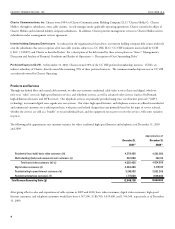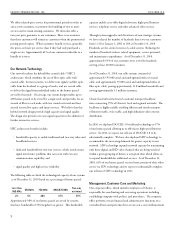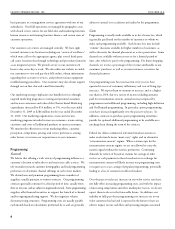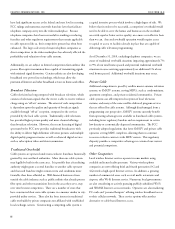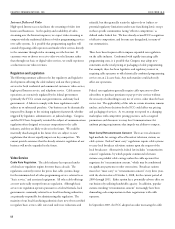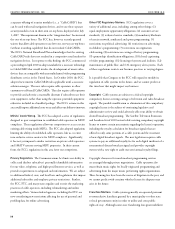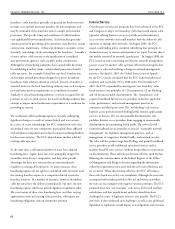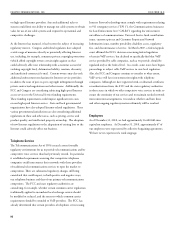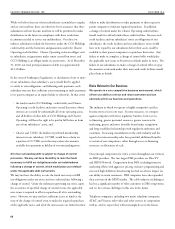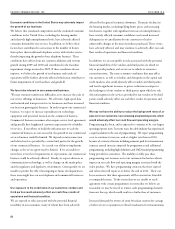Charter 2010 Annual Report Download - page 24
Download and view the complete annual report
Please find page 24 of the 2010 Charter annual report below. You can navigate through the pages in the report by either clicking on the pages listed below, or by using the keyword search tool below to find specific information within the annual report.
have had significant success at the federal and state level in securing
FCC rulings and numerous statewide franchise laws that facilitate
telephone company entry into the video marketplace. Because
telephone companies have been successful in avoiding or reducing
franchise and other regulatory requirements that remain applicable
to cable operators like us, their competitive posture has often been
enhanced. e large scale entry of major telephone companies as
direct competitors in the video marketplace has adversely affected the
profitability and valuation of our cable systems.
Additionally, we are subject to limited competition from utilities that
possess fiber optic transmission lines capable of transmitting signals
with minimal signal distortion. Certain utilities are also developing
broadband over power line technology, which may allow the
provision of Internet and other broadband services to homes and offices.
Broadcast Television
Cable television has long competed with broadcast television, which
consists of television signals that the viewer is able to receive without
charge using an “off-air” antenna. e extent of such competition
is dependent upon the quality and quantity of broadcast signals
available through “off-air” reception, compared to the services
provided by the local cable system. Traditionally, cable television
has provided higher picture quality and more channel offerings
than broadcast television. However, the recent licensing of digital
spectrum by the FCC now provides traditional broadcasters with
the ability to deliver high definition television pictures and multiple
digital-quality program streams, as well as advanced digital services
such as subscription video and data transmission.
Traditional Overbuilds
Cable systems are operated under non-exclusive franchises historically
granted by state and local authorities. More than one cable system
may legally be built in the same area. It is possible that a franchising
authority might grant a second franchise to another cable operator
and that such franchise might contain terms and conditions more
favorable than those afforded us. Well-financed businesses from
outside the cable industry, such as public utilities that already possess
fiber optic and other transmission lines in the areas they serve, may
over time become competitors. ere are a number of cities that
have constructed their own cable systems, in a manner similar to city-
provided utility services. ere also has been interest in traditional
cable overbuilds by private companies not affiliated with established
local exchange carriers. Constructing a competing cable system is
a capital intensive process which involves a high degree of risk. We
believe that in order to be successful, a competitor’s overbuild would
need to be able to serve the homes and businesses in the overbuilt
area with equal or better service quality, on a more cost-effective basis
than we can. Any such overbuild operation would require access
to capital or access to facilities already in place that are capable of
delivering cable television programming.
As of December 31, 2010, excluding telephone companies, we are
aware of traditional overbuild situations impacting approximately 7%
to 9% of our total homes passed and potential traditional overbuild
situations in areas servicing approximately an additional 1% of our
total homes passed. Additional overbuild situations may occur.
Private Cable
Additional competition is posed by satellite master antenna television
systems, or SMATV systems, serving MDUs, such as condominiums,
apartment complexes, and private residential communities. Private
cable systems can offer improved reception of local television
stations, and many of the same satellite-delivered program services
that are offered by cable systems. Although disadvantaged from a
programming cost perspective, SMATV systems currently benefit
from operating advantages not available to franchised cable systems,
including fewer regulatory burdens and no requirement to service
low density or economically depressed communities. e FCC
previously adopted regulations that favor SMATV and private cable
operators serving MDU complexes, allowing them to continue
to secure exclusive contracts with MDU owners. is regulatory
disparity provides a competitive advantage to certain of our current
and potential competitors.
Other Competitors
Local wireless Internet services operate in some markets using
available unlicensed radio spectrum. Various wireless phone
companies are now offering third and fourth generation (3G and
4G) wireless high-speed Internet services. In addition, a growing
number of commercial areas, such as retail malls, restaurants and
airports, offer Wi-Fi Internet service. Numerous local governments
are also considering or actively pursuing publicly subsidized Wi-Fi
and WiMAX Internet access networks. Operators are also marketing
PC cards and “personal hotspots” offering wireless broadband access
to their cellular networks. ese service options offer another
alternative to cable-based Internet access.





